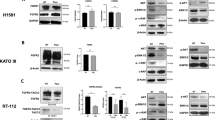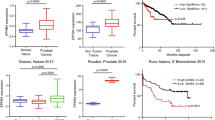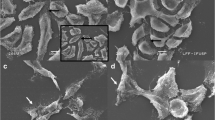Abstract
Increased activity of the EGF system exerts a cell survival function in the presence of cytotoxic agents. The aim of our investigation was to identify the ligands and receptors from the EGF system, that are induced by the chemotherapeutic DNA damaging agent VP16 in bladder cancer cell lines. By use of real-time RT-PCR assays for all four receptors and six ligands from the EGF system we demonstrate that in HCV29 bladder cancer cells, amphiregulin, HB-EGF, and epiregulin mRNA levels are elevated (more than 100, 5, and 4 fold, respectively) by VP16. The remaining ligands (EGF, TGFα and betacellulin) are uninduced. The same was found for T24A bladder cancer cells, except that TGFα also was induced. The four receptors were reduced by VP16 in both cell lines. This demonstrates that the induction of the EGF system is mediated by an increased expression of a subset of the ligands, whereas the four receptors are reduced. For amphiregulin and HER1 we investigated with ELISA assays if the effects of VP16 also were observed at the protein level. We found that VP16 increase the amount of amphiregulin peptide both in the cell membrane and the culture medium. Similarly, the reduced EGF receptor mRNA expression correlated with reduced HER1 protein.
Several investigations have shown that labile protein factors can be involved in the regulation of stress inducible growth factors and cytokines. We investigated if a labile protein regulates the expression of the subset of ligands that were induced with VP16. Blocking of protein neosynthesis with cycloheximide resulted in induced mRNA expression of exactly the same subset of ligands as observed with VP16 treatment of both HCV29 and T24A cells. This suggests that a labile protein factor regulates either the transcription or degradation of these mRNA's, and it can be speculated that VP16 also operate by inhibiting the activity of this factor. This is further stressed by the observation that combined treatment with cycloheximide and VP16 show no additive effect.
In conclusion, we show that a subset of ligands from the EGF system is upregulated by VP16, whereas none of the four receptors are induced. This might represent a physiological response aimed at rescuing the cells.
Similar content being viewed by others
References
Lemmon MA, Schlessinger J: Regulation of signal-transduction and signal diversity by receptor oligomerization. Trends Biochem Sci 19: 459-463, 1994
Beerli RR, Hynes NE: Epidermal growth factor-related peptides activate distinct subsets of ErbB receptors and differ in their biological activities. J Biol Chem 271: 6071-6076, 1996
Olayioye MA, Graus-Porta D, Beerli RR, Rohrer J, Gay B, Hynes NE: ErbB-1 and ErbB-2 acquire distinct signaling properties dependent upon their dimerization partner. Mol Cell Biol 18: 5042-5051, 1998
Riese DJ, Stern DF: Specificity within the EGF family ErbB receptor family signaling network. Bioessays 20: 41-48, 1998
Klapper LN, Vaisman N, Hurwitz E, PinkasKramarski R, Yarden Y, Sela M: A subclass of tumor-inhibitory monoclonal antibodies to ErbB-2/HER2 blocks crosstalk with growth factor receptors. Oncogene 14: 2099-2109, 1997
Gibson S, Tu S, Oyer R, Anderson SM, Johnson GL: Epidermal growth factor protects epithelial cells against Fas-induced apoptosis. Requirement for Akt activation. J Biol Chem 274: 17612-17618, 1999
Lin JQ, Adam RM, Santiestevan E, Freeman MR: The phosphatidylinositol 3′-kinase pathway is a dominant growth factor-activated cell survival pathway in LNCaP human prostate carcinoma cells. Cancer Res 59: 2891-2897, 1999
Yu DH, Tian J, Liu BL, Yao J, Tan M, McDonnell TJ, Hung MC: Over-expression of ErbB2 blocks taxol-induced apoptosis by upregulation of p21(Cip1), which inhibits p34(Cdc2) kinase. Mol Cell 2: 581-591, 1998
Mellon JK, Cook S, Chambers P, Neal DE: Transforming growth factor alpha and epidermal growth factor levels in bladder cancer and their relationship to epidermal growth factor receptor. Br J Cancer 73: 654-658, 1996
Thogersen VB, Sorensen BS, Poulsen SS, Orntoft TF, Wolf H, Nexo E: A subclass of HER1 ligands are prognostic markers for survival in bladder cancer patients. Cancer Res 61: 6227-6233, 2001
Torring N, Jorgensen PE, Sorensen BS, Nexo E: Increased expression of heparin binding EGF (HB-EGF), amphiregulin, TGF alpha and epiregulin in androgen-independent prostate cancer cell lines. Anticancer Res 20: 91-95, 2000
Christensen ME, Engbaek F, Therkildsen MH, Bretlau P, Nexo E: A sensitive enzyme-linked immunosorbent assay used for quantitation of epidermal growth factor receptor protein in head and neck carcinomas: Evaluation, interpretations and limitations. Br J Cancer 72: 1487-1493, 1995
Evan GI, Vousden KH: Proliferation, cell cycle and apoptosis in cancer. Nature 411: 342-348, 2001
Horikawa M, Higashiyama S, Nomura S, Kitamura Y, Ishikawa M, Taniguchi N: Upregulation of endogenous heparin-binding EGF-like growth factor and its role as a survival factor in skeletal myotubes. FEBS Lett 459: 100-104, 1999
Takemura T, Kondo S, Homma T, Sakai M, Harris RC: The membrane-bound form of heparin-binding epidermal growth factor-like growth factor promotes survival of cultured renal epithelial cells. J Biol Chem 272: 31036-31042, 1997
Miyazaki Y, Hiraoka S, Tsutsui S, Kitamura S, Shinomura Y, Matsuzawa Y: Epidermal growth factor receptor mediates stress-induced expression of its ligands in rat gastric epithelial cells. Gastroenterology 120: 108-116, 2001
Schulze A, Lehmann K, Jefferies HBJ, McMahon M, Downward J: Analysis of the transcriptional program induced by Raf in epithelial cells. Genes Dev 15: 981-994, 2001
Nishigori C, Yarosh DB, Ullrich SE, Vink AA, Bucana CD, Roza L, Kripke ML: Evidence that DNA damage triggers interleukin 10 cytokine production in UV-irradiated murine keratinocytes. Proc Natl Acad Sci USA 93: 10354-10359, 1996
Petit-Frere C, Clingen PH, Grewe M, Krutmann J, Roza L, Arlett CF, Green MHL: Induction of interleukin-6 production by ultraviolet radiation in normal human epidermal keratinocytes and in a human keratinocyte cell line is mediated by DNA damage. J Invest Dermatol 111: 354-359, 1998
Sell C, Baserga R, Rubin R: Insulin-like growth factor I (IGF-I) and the IGF-I receptor prevent etoposide-induced apoptosis. Cancer Res 55: 303-306, 1995
Baselga J, Albanell J: Targeting epidermal growth factor receptor in lung cancer. Curr Oncol Rep 4: 317-324, 2002
Baselga J: Targeting the epidermal growth factor receptor with tyrosine kinase inhibitors: Small molecules, big hopes. J Clin Oncol 20: 2217-2219, 2002
Ross JS, Fletcher JA: The HER-2/neu oncogene in breast cancer: Prognostic factor, predictive factor, and target for therapy. Stem Cells 16: 413-428, 1998
Author information
Authors and Affiliations
Rights and permissions
About this article
Cite this article
Sørensen, B.S., Tørring, N., Bor, M.V. et al. The DNA damaging agent VP16 induces the expression of a subset of ligands from the EGF system in bladder cancer cells, whereas none of the four EGF receptors are induced. Mol Cell Biochem 260, 129–135 (2004). https://doi.org/10.1023/B:MCBI.0000026063.96267.98
Issue Date:
DOI: https://doi.org/10.1023/B:MCBI.0000026063.96267.98




